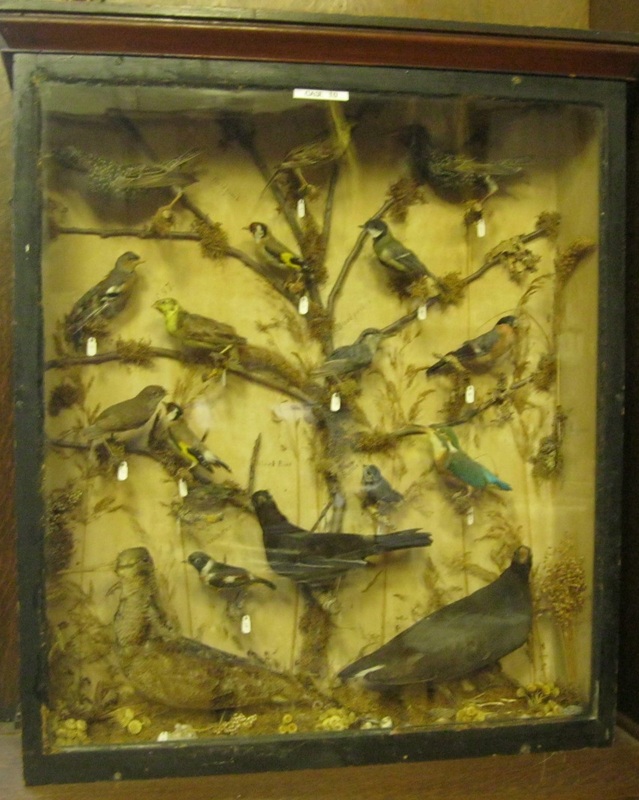Case 10Located in the Faith Crandall Scott Reference Room situated to the LEFT of the fireplace on the RIGHT of the window Case 10 is home to 18 birds two of which are Starlings. This case has the labels of the birds handwritten inside the case with the date 1847 written in it, making the birds in this case over 160 years old. Several birds in the case have been re-identified as something other then they are labeled, Please Help Us make sure that our labels are correct. You can go to our Unidentified Birds Page and fill out the form.
Thank You for your help. |
Nightingale
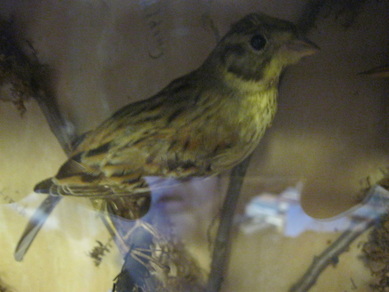
Case 10, Bird 1; The Nightingale *Labeled in the case as Yawlding
The Nightingale (Luscinia megarhynchos), also known as Rufous and Common Nightingale, is a small passerine bird that was formerly classed as a member of the thrush family and also belongs to a group of more terrestrial species, often called chats. The nightingale is slightly larger than the European Robin, Nightingales are named so because they frequently sing at night as well as during the day. The name has been used for well over 1,000 years, being highly recognizable even in its Anglo-Saxon form – 'nightingale'. It means 'night songstress'. Early writers assumed the female sang when it is in fact the male. The song is loud, with an impressive range of whistles, trills and gurgles. Its song is particularly noticeable at night because few other birds are singing. This is why its name includes "night" in several languages. Only unpaired males sing regularly at night, and nocturnal song is likely to serve attracting a mate. Singing at dawn, during the hour before sunrise, is assumed to be important in defending the bird's territory. Nightingales sing even more loudly in urban or near-urban environments, in order to overcome the background noise. The most characteristic feature of the song is a loud whistling crescendo, absent from the song of Thrush Nightingale. It has a frog-like alarm call.
Starling
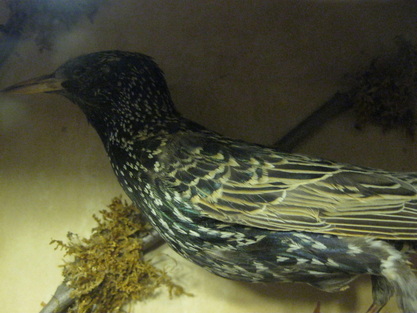
Case 10, Bird 2; The Common Starling
*there are two Starlings in the case
The Common Starling (Sturnus vulgaris), also known as the European Starling or just Starling, is a passerine bird in the family Sturnidae. This species of starling is native to most of temperate Europe and western Asia. It is resident in southern and western Europe and southwestern Asia. It is among the most familiar of birds in temperate regions. The Common Starling is a noisy bird uttering a wide variety of both melodic and mechanical-sounding sounds, including a distinctive "wolf-whistle". Starlings are mimics, like many of its family. In captivity, Starlings will learn to imitate all types of sounds and speech earning them the nickname "poor-man's Myna".Common Starlings prefer urban or suburban areas where artificial structures and trees provide adequate nesting and roosting sites. They also commonly reside in grassy areas where foraging is easy—such as farmland, grazing pastures, playing fields, golf courses, and airfields. Flock size is highly variable, with huge flocks providing a spectacular sight and sound usually occurring near roosts. The European Starling is insectivorous, and typically consumes insects including caterpillars, moths, and cicadas, as well as spiders. Unpaired males begin to build nests in order to attract single females. Males often decorate the nest with ornaments (such as flowers) and fresh green material which the female later disassembles upon accepting him as a mate. The males sing throughout much of the construction and even more so when a female approaches his nest. Following copulation, the male and female continue to build the nest. Common nesting locations include inside hollowed trees, buildings, tree stumps, and man-made nest-boxes. Nests are typically made out of straw, dry grass, twigs and inner lining made up of feathers, wool, and soft leaves. Construction typically takes 4 to 5 days and may continue through incubation. Fresh herbs are added to nests and work as insect repellent. The breeding season begins in early spring and summer. Following copulation, female European Starlings will lay an egg on a daily basis over a period of several days. If an egg is lost during this time period, she will lay another egg to replace it. The eggs (4-5) are small elliptical blue (and occasionally white) eggs that commonly have a glossy appearance to them.[21] Incubation lasts 13 days, although the last egg laid may take 24 hours longer than the first to hatch. Both parents share the responsibility of sitting on top of the eggs. However, the female spends more time incubating the eggs than the male, and is the only parent to do so at night (while the male returns to the communal roost) The young are born blind and naked. They develop light fluffy down within 7 days of hatching and sight within 9 days. Nestlings remain in the nest for 3 weeks, where they are fed continuously by both their parents. Fledglings continue to be fed by their parents for 1–2 weeks. Pairs can raise up to three broods per breeding season, frequently reusing and relining the same nest. Within two months, most juveniles have molted and gained their first basic plumage. Juveniles acquire their adult plumage the following year.
European Goldfinch
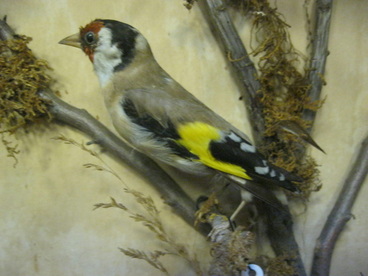
Case 10, Bird 3; European Goldfinch * Labeled as just Goldfinch
The European Goldfinch or Goldfinch (Carduelis carduelis) is a small passerine bird in the finch family. The goldfinch breeds across Europe, North Africa, and western and central Asia, in open, partially wooded lowlands. It is resident in the milder west of its range, but migrates from colder regions. It will also make local movements, even in the west, to escape bad weather. It has been introduced to many areas of the world. The goldfinch's preferred food is small seeds such as those from thistles (the Latin name is from Carduus, a genus of thistles) and teasels, but insects are also taken when feeding young. It also regularly visits bird feeders in winter. They nest in the outer twigs of tall leafy trees, or even in bamboo, laying four to six eggs which hatch in 11–14 days. In the winter goldfinches group together to form flocks of up to forty birds, occasionally more.The song is a pleasant silvery twittering. In earlier times, the Goldfinch was kept as a cagebird for its song. Goldfinches are attracted to back gardens in Europe and North America by birdfeeders containing niger (commercially described as nyjer) seed. Goldfinches are commonly kept and bred in captivity around the world because of their distinctive appearance and pleasant song.
Great Tit
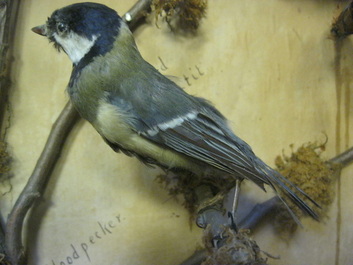
Case 10, Bird 4; The Great Tit *Labeled as Black head Tomtit
The Great Tit (Parus major) is a passerine bird in the tit family Paridae. It is a widespread and common species throughout Europe, the Middle East, Central and Northern Asia, and parts of North Africa in any sort of woodland. It is generally resident, and most Great Tits do not migrate except in extremely harsh winters. It is predominantly insectivorous in the summer, but will consume a wider range of food items in the winter months, including small hibernating bats. Like all tits it is a cavity nester, usually nesting in a hole in a tree. The female lays around 12 eggs and incubates them alone, although both parents raise the chicks. In most years the pair will raise two broods. The nests may be raided by woodpeckers, squirrels and weasels and infested with fleas, and adults may be hunted by Sparrowhawks. The Great Tit has adapted well to human changes in the environment and is a common and familiar bird in urban parks and gardens. The Great Tit occupies a range of habitats. It is most commonly found in open deciduous woodland, mixed forests and forest edges. In dense forests, including conifer forests it is usually found in forest clearings. Great Tits, along with other tits, will join winter mixed-species foraging flocks.Great Tits are seasonal breeders. The exact timing of breeding varies by a number of factors, most importantly location. Great Tits are cavity nesters, breeding in a hole that is usually inside a tree, although occasionally in a wall or rock face, and they will readily take to nest boxes. The nest inside the cavity is built by the female, and is made of plant fibres, grasses, moss, hair, wool and feathers. The number in the clutch is often very large, as many as 18, but five to twelve is more common. The chicks, like those of all tits, are hatched unfeathered and blind. Chicks are fed by both parents, usually receiving 6–7 g of food a day. Both parents provision the chicks with food.
Chaffinch
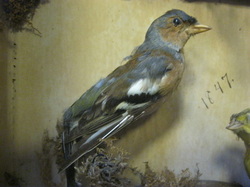
Case 10, Bird 5; The Chaffinch
The Chaffinch (Fringilla coelebs), also called by a wide variety of other names, is a small passerine bird in the finch family Fringillidae. This bird is widespread and very familiar throughout Europe. It is the most common finch in western Europe, and the second most common bird in the British Isles. It was introduced from Britain into a number of its overseas territories in the 18th and 19th centuries. In New Zealand it is a common species. It uses a range of habitats, but open woodland is favoured, although it is common in gardens and on farmland.
Unidentified
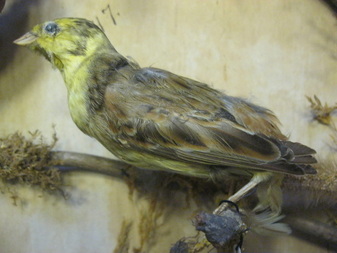
Case 10, Bird 6; Labeled as Yellow Lambird or Yawlding
This Bird Identified as a Yellow Lambird or Yawlding by the handwritten Label we are saying this is an unidentified bird and would like your help in discovering the true name and classification of this bird. Please visit our Unidentified Birds Page and help us.
Woodpecker
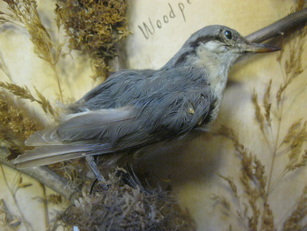
Case 10, Bird 7; Woodpecker
The woodpeckers, piculets, wrynecks, and sapsuckers are a family, Picidae, of near-passerine birds. Members of this family are found worldwide, except for Australia, New Zealand, Madagascar, and the extreme polar regions. Most species live in forests or woodland habitats, although a few species are known to live in treeless areas, such as rocky hillsides and deserts.
The Picidae are just one of the eight living families in the order Piciformes. Members of the order Piciformes, such as the jacamars, puffbirds, barbets, toucans, and honeyguides, have traditionally been thought to be very closely related to the woodpeckers, piculets, wrynecks, and sapsuckers. More recently, DNA sequence analyses have confirmed this view. There are about 200 species and about 30 genera in this family. Many species are threatened or endangered due to loss of habitat or habitat fragmentation. Two species of woodpeckers, the Ivory-billed Woodpecker and the Imperial Woodpecker, have been considered extinct for about 30 years.
*Please Help Us Identify the Species of Woodpecker by going to our Unidentified Birds Page*
The Picidae are just one of the eight living families in the order Piciformes. Members of the order Piciformes, such as the jacamars, puffbirds, barbets, toucans, and honeyguides, have traditionally been thought to be very closely related to the woodpeckers, piculets, wrynecks, and sapsuckers. More recently, DNA sequence analyses have confirmed this view. There are about 200 species and about 30 genera in this family. Many species are threatened or endangered due to loss of habitat or habitat fragmentation. Two species of woodpeckers, the Ivory-billed Woodpecker and the Imperial Woodpecker, have been considered extinct for about 30 years.
*Please Help Us Identify the Species of Woodpecker by going to our Unidentified Birds Page*
Bullfinch
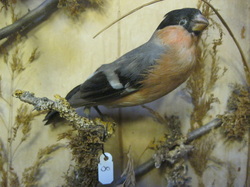
Case 10, Bird 8; The Bullfinch
The Bullfinch, Common Bullfinch or Eurasian Bullfinch (Pyrrhula pyrrhula) is a small passerine bird in the finch family Fringillidae. This bird breeds across Europe and temperate Asia. It is mainly resident, but many northern birds migrate further south in the winter. Mixed woodland with some conifers is favoured for breeding, including parkland and gardens. It builds its nest in a bush, (preferably more than 4 metres tall and wide),mature stands of scrub, or tree, laying 4-7 eggs. The food is mainly seeds and buds of fruit trees, which can make it a pest in orchards. Ash and hawthorn are favoured in autumn and early winter. If wild bird cover is planted for it, Kale, Quinoa and Millet are preferred, next to tall hedges or woodland. This species does not form large flocks outside the breeding season, and is usually seen as a pair or family group. The Bullfinch is a bulky bull-headed bird. The upper parts are grey; the flight feathers and short thick bill are black; as are the cap and face in adults (they are greyish-brown in juveniles), and the white rump and wing bars are striking in flight. The adult male has red underparts, but females and young birds have grey-buff underparts. The pleasant song of this unobtrusive bird contains fluted whistles.
Nightingale
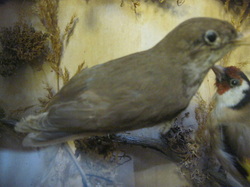
Case 10, Bird 9; The Nightingale
The Nightingale (Luscinia megarhynchos), also known as Rufous and Common Nightingale, is a small passerine bird that was formerly classed as a member of the thrush family Turdidae, but is now more generally considered to be an Old World flycatcher, Muscicapidae. It belongs to a group of more terrestrial species, often called chats. It is a migratory insectivorous species breeding in forest and scrub in Europe and south-west Asia, but is not found naturally in the Americas. The distribution is more southerly than the very closely related Thrush Nightingale Luscinia luscinia. It nests on the ground within or next to dense bushes. It winters in southern Africa. Nightingales are named so because they frequently sing at night as well as during the day. The name has been used for well over 1,000 years, being highly recognizable even in its Anglo-Saxon form – 'nightingale'. It means 'night songstress'. Early writers assumed the female sang when it is in fact the male. The song is loud, with an impressive range of whistles, trills and gurgles. Its song is particularly noticeable at night because few other birds are singing. This is why its name includes "night" in several languages. Only unpaired males sing regularly at night, and nocturnal song is likely to serve attracting a mate. Singing at dawn, during the hour before sunrise, is assumed to be important in defending the bird's territory. Nightingales sing even more loudly in urban or near-urban environments, in order to overcome the background noise. The most characteristic feature of the song is a loud whistling crescendo, absent from the song of Thrush Nightingale. It has a frog-like alarm call.
European Goldfinch
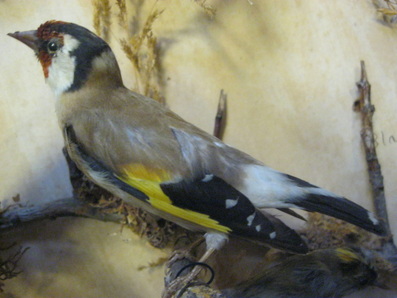
Case 10, Bird 10; The European Goldfinch *Labeled as Golden Wren
The European Goldfinch or Goldfinch (Carduelis carduelis) is a small passerine bird in the finch family. The goldfinch breeds across Europe, North Africa, and western and central Asia, in open, partially wooded lowlands. It is resident in the milder west of its range, but migrates from colder regions. It will also make local movements, even in the west, to escape bad weather. It has been introduced to many areas of the world. The goldfinch's preferred food is small seeds such as those from thistles (the Latin name is from Carduus, a genus of thistles) and teasels, but insects are also taken when feeding young. It also regularly visits bird feeders in winter. They nest in the outer twigs of tall leafy trees, or even in bamboo, laying four to six eggs which hatch in 11–14 days. In the winter goldfinches group together to form flocks of up to forty birds, occasionally more.The song is a pleasant silvery twittering. In earlier times, the Goldfinch was kept as a cagebird for its song. Goldfinches are attracted to back gardens in Europe and North America by birdfeeders containing niger (commercially described as nyjer) seed. Goldfinches are commonly kept and bred in captivity around the world because of their distinctive appearance and pleasant song.
Black Cap or Wheatear
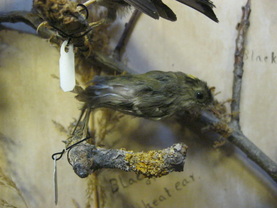
Case 10, Bird 11; Black Cap or Wheatear
This Bird needs Identifying please help Us Correctly Identify him by going to our Unidentified Birds Page.
Bottle Tit
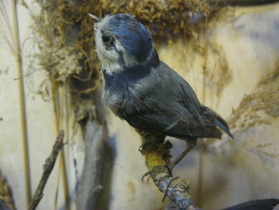
Case 10, Bird 12; Bottle Tit
The Blue Tit (Cyanistes caeruleus or Parus caeruleus) is a small passerine bird in the tit family Paridae. The bird is easily recognisable by its blue and yellow plumage, but its scientific classification is disputed.
Blue tits, usually resident and non-migratory birds, are widespread and a common resident breeder throughout temperate and subarctic Europe and western Asia in deciduous or mixed woodlands with a high proportion of oak. They usually nest in tree holes, although they easily adapt to nest boxes where necessary. The main rival for nests and search for food is the much larger Great Tit.
The blue tit prefers insects and spiders for their diet. Outside the breeding season, they also eat seeds and other vegetable-based foods. Blue tits are famed for their skill, as they can cling to the outermost branches and hang upside down when looking for food. The systematics of the Blue Tit complex are disputed. There are currently at least nine recognised subspecies: C. c. caeruleus, C. c. obscurus, C. c. ogilastrae, C. c. balearicus, C. c. calamensis, C. c. orientalis, C. c. satunini, C. c. raddei, and C. c. persicus. The Blue Tit is usually 12 centimetres (4.7 in) long with a wingspan of 18 centimetres (7.1 in) for all genders, and weighs about 11 grams (0.39 oz). A typical Blue Tit has an azure blue crown and dark blue line passing through the eye, and encircling the white cheeks to the chin, giving the bird a very distinctive appearance. The forehead and a bar on the wing are white. The nape, wings and tail are blue and the back is yellowish green. The underparts is mostly sulphur-yellow with a dark line down the abdomen - the yellowness is indicative of the number of yellowy-green caterpillars eaten, due to high levels of carotene pigments in the diet. The bill is black, the legs bluish grey, and the irides dark brown. The sexes are similar, but under ultraviolet light, males have a brighter blue crown. Young Blue Tits are noticeably more yellow.
The Blue Tit and the related hybrids are considered native species in areas of the European continent with a mainly temperate or Mediterranean climate, and in parts of the Middle East and North Africa. These areas include the United Kingdom and most of the European Economic Area (except Malta, where they are considered vagrant, and Iceland, where they are absent), plus: Albania, Algeria, Armenia, Azerbaijan, Belarus, Bosnia and Herzegovina, Croatia, Georgia, Iran, Iraq, Jordan, Kazakhstan, Lebanon, Libya, Macedonia (former Yugoslav Republic), Moldova, Montenegro, Morocco, Russia, Serbia, Switzerland, Syria, Tunisia, Turkey and Ukraine.
Blue tits, usually resident and non-migratory birds, are widespread and a common resident breeder throughout temperate and subarctic Europe and western Asia in deciduous or mixed woodlands with a high proportion of oak. They usually nest in tree holes, although they easily adapt to nest boxes where necessary. The main rival for nests and search for food is the much larger Great Tit.
The blue tit prefers insects and spiders for their diet. Outside the breeding season, they also eat seeds and other vegetable-based foods. Blue tits are famed for their skill, as they can cling to the outermost branches and hang upside down when looking for food. The systematics of the Blue Tit complex are disputed. There are currently at least nine recognised subspecies: C. c. caeruleus, C. c. obscurus, C. c. ogilastrae, C. c. balearicus, C. c. calamensis, C. c. orientalis, C. c. satunini, C. c. raddei, and C. c. persicus. The Blue Tit is usually 12 centimetres (4.7 in) long with a wingspan of 18 centimetres (7.1 in) for all genders, and weighs about 11 grams (0.39 oz). A typical Blue Tit has an azure blue crown and dark blue line passing through the eye, and encircling the white cheeks to the chin, giving the bird a very distinctive appearance. The forehead and a bar on the wing are white. The nape, wings and tail are blue and the back is yellowish green. The underparts is mostly sulphur-yellow with a dark line down the abdomen - the yellowness is indicative of the number of yellowy-green caterpillars eaten, due to high levels of carotene pigments in the diet. The bill is black, the legs bluish grey, and the irides dark brown. The sexes are similar, but under ultraviolet light, males have a brighter blue crown. Young Blue Tits are noticeably more yellow.
The Blue Tit and the related hybrids are considered native species in areas of the European continent with a mainly temperate or Mediterranean climate, and in parts of the Middle East and North Africa. These areas include the United Kingdom and most of the European Economic Area (except Malta, where they are considered vagrant, and Iceland, where they are absent), plus: Albania, Algeria, Armenia, Azerbaijan, Belarus, Bosnia and Herzegovina, Croatia, Georgia, Iran, Iraq, Jordan, Kazakhstan, Lebanon, Libya, Macedonia (former Yugoslav Republic), Moldova, Montenegro, Morocco, Russia, Serbia, Switzerland, Syria, Tunisia, Turkey and Ukraine.
Kingfisher
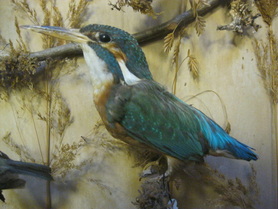
Case 10, Bird 13; The Kingfisher
The Sacred Kingfisher (Todiramphus sanctus) is primarily a woodland kingfisher that occurs in mangroves, woodlands, forests, and river valleys of Australia, Populations in the southern two-thirds of Australia migrate northwards at the end of breeding season to New Guinea, east to the E Solomon Is and west to Indonesia. Birds move south again to Australia in August to September. It is 19–23 cm (7.5–9.1 in) long, and feeds on insects, small crustaceans, fish, small rodents and reptiles but reports of it eating small finches are rare. It is a migratory insectivorous species breeding in forest and scrub in Europe and south-west Asia, but is not found naturally in the Americas. It nests on the ground within or next to dense bushes. It winters in southern Africa.
Unknown
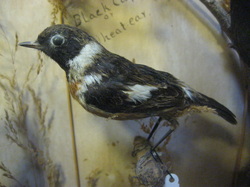
Case 10; Bird 14;
This bird is the only bird in case ten not to be labeled Please help us find out what species of bird this is by going to our Unidentified Birds Page.
Common Black Bird
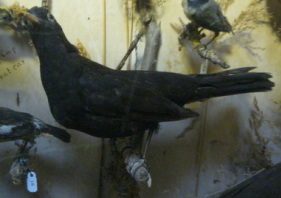
Case 10, Bird 15; The Common Black Bird
The Common Blackbird (Turdus merula) is a species of true thrush. Both sexes are territorial on the breeding grounds, with distinctive threat displays, but are more gregarious during migration and in wintering areas. Pairs will stay in their territory throughout the year where the climate is sufficiently temperate. This common and conspicuous species has given rise to a number of literary and cultural references, frequently related to its song. Common over most of its range in woodland, the Common Blackbird has a preference for deciduous trees with dense undergrowth. As long as winter food is available, both the male and female will remain in the territory throughout the year, although occupying different areas. Migrants are more gregarious, travelling in small flocks and feeding in loose groups in the wintering grounds. The Common Blackbird is omnivorous, eating a wide range of insects, earthworms, seeds and berries. It feeds mainly on the ground, running and hopping with a start-stop-start progress. It pulls earthworms from the soil, usually finding them by sight, but sometimes by hearing, and roots through leaf litter for other invertebrates. Small vertebrates such as frogs, tadpoles and lizards are occasionally hunted. This species will also perch in bushes to take berries and collect caterpillars and other active insects.
Woodcock
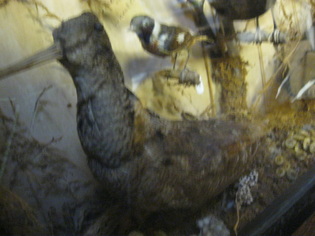
Case 10, Bird 16; The Woodcock
The Woodcocks are a group of seven or eight very similar living species of wading birds in the genus Scolopax. Only two woodcocks are widespread, the others being localized island endemics. Most are found in the Northern Hemisphere but a few range into Wallacea. Their closest relatives are the typical snipes of the genus Gallinago. Woodcocks have stocky bodies, cryptic brown and blackish plumage and long slender bills. Their eyes are located on the sides of their heads, which gives them 360° vision. Unlike in most birds, the tip of the bill's upper mandible is flexible. As their common name implies, the woodcocks are woodland birds. They feed at night or in the evenings, searching for invertebrates in soft ground with their long bills. This habit and their unobtrusive plumage makes it difficult to see them when they are resting in the day. All woodcocks are popular gamebirds; the island endemic species are often quite rare already due to overhunting. The pin feathers of the woodcock are much esteemed as brushtips by artists, who use them for fine painting work. The pin feather is the covert of the leading primary feather of the wing.
Moorhen
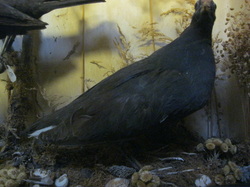
Case 10, Bird 17; The Moorhen
Moorhens, sometimes called marsh hens, are medium-sized water birds that are members of the rail family Rallidae. They constitute the genus Gallinula. They are close relatives of coots, and because of their apparently nervous behavior (frequently twitching tail, neck and grinding their backs) are sometimes called "skitty coots". Often, they are referred to as (black) gallinules. Moorhens can walk very well on strong legs, and have long toes that are well adapted to soft uneven surfaces. These birds are omnivorous taking plant material, small rodents, amphibians and eggs. They are aggressively territorial during the breeding season, but are otherwise often found in sizeable flocks on the shallow vegetated lakes they prefer.
